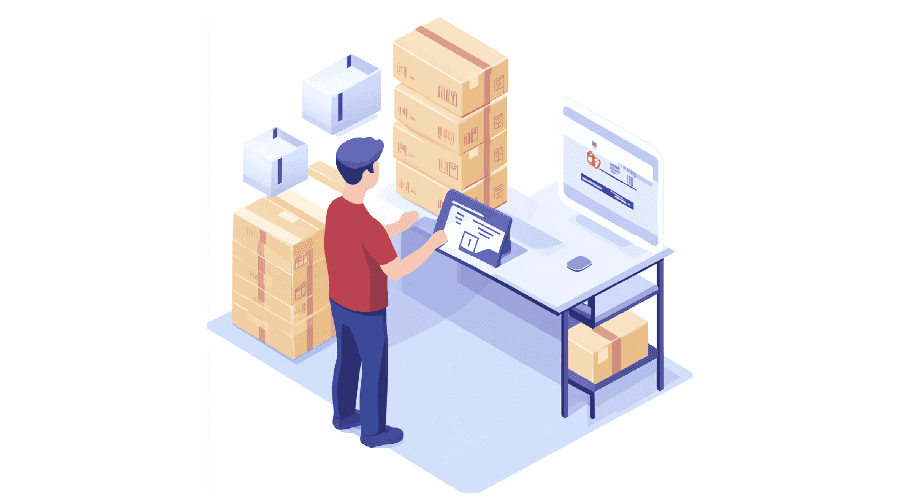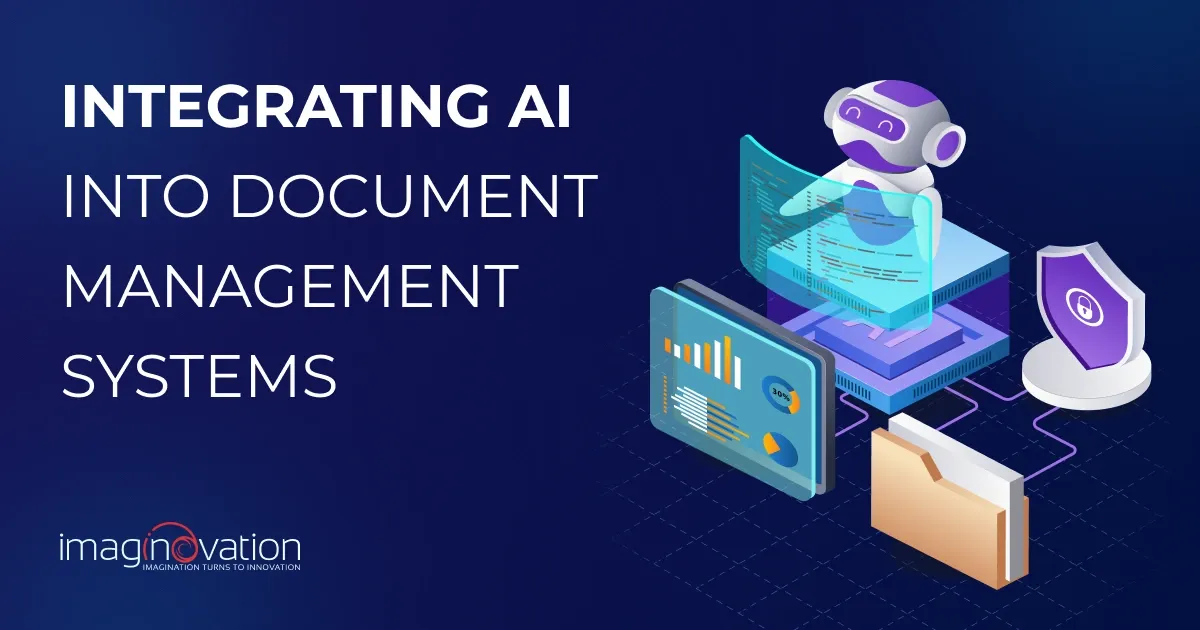To estimate the cost of building a website or an app, use our app cost calculator tool.
The Internet of Things (IoT) is transforming the business landscape, and inventory management is no exception. In today's fast-paced, tech-driven world, traditional inventory methods cannot match the demands for efficiency and accuracy. Enter IoT—a game-changer that is revolutionizing how businesses manage their inventory.
IoT in inventory management is phenomenal today. It offers numerous benefits, from enhanced efficiency to improved accuracy and reduced costs. Naturally, you'd want to leverage practical ways to use IoT.
Keep reading this IoT Implementation Guide as we explore key benefits, challenges, and more. Let's dive in!
Understanding IoT in Inventory Management
Here's the thing—IoT has a lot of potential! It is critical to tap into its prospects, and the first step is to start with the basics. Let's look at what IoT is.
Picture a world where everyday objects can talk to each other. Now, that would be cool—isn't it? That's where the Internet of Things (IoT) plays a critical role; it's a network of gadgets equipped with sensors and software, allowing them to share data over the Internet.
At the heart of IoT lies a sophisticated architecture, involving sensors that gather data. Further, the connectivity channels transmit it, edge devices process it locally, and cloud systems store and analyze it. The interconnected system is responsible for transforming ordinary objects into intelligent assistants.
Let's look at some numbers—according to a report by McKinsey Global Institute, IoT has the potential economic impact of $3.9 trillion to $11.1 trillion per year by 2025, spanning a range of industries including healthcare, retail, and manufacturing.
In another study, according to Fortune Business Insights, experts predict the global market for IoT in warehouse management to touch around $28.79 billion by 2030.
The numbers speak volumes and it isn’t surprising as IoT revolutionizes various sectors by enhancing efficiency and sustainability. For example—in manufacturing, sensors check production lines to optimize energy usage for smooth operations. In healthcare, wearable devices are of big support as they can help track vital signs. The data can be used for personalized care. Meanwhile, retail leverages IoT to optimize inventory and improve customer engagement.
As the business landscape is thriving with success stories of digital transformation, IoT solutions will continue to be a pivotal force, supporting inventory management. Next up, let's look at some key benefits.
Key Benefits of IoT in Inventory Management
As IoT continues to reshape various industries, inventory management has emerged as one of the primary beneficiaries of this technological innovation. Let's explore the key benefits of implementing IoT in inventory management.
Improved Accuracy and Fewer Errors
IoT in inventory management significantly improves accuracy and reduces errors by automating data collection. Further, it supports real-time monitoring and integration with other systems for seamless operations.
Traditionally, many warehouses find it difficult to control their inventory accurately because of human mistakes or lack of visibility. It is usual to find situations where there are misplaced items or misread labels. In such scenarios, it can impact the flow of goods, leading to poor customer service, and have other financial implications.
By automating and using smart devices and sensors, businesses can automate the collection and analysis of inventory data. Thus, it is easier to locate tagged items. Further, there are no items lost in inventory, and the inventory for each item will stay updated and accurate.
For example, RFID tags and readers can come in handy to track the movement of items in a warehouse or store, without requiring human intervention. Here's a good example— Walmart, the American international retail corporation uses IoT technology to track inventory levels in real-time across its vast network of stores, reducing stockouts and improving replenishment efficiency.
Enhanced Stock Monitoring and Control
Implementing IoT in inventory management can streamline and enhance stock monitoring and control. Picture this*:* at warehouses, you can spend hours searching for misplaced items. Traditional inventory management can be loaded with time-intensive tasks.
In such scenarios, IoT solutions can help—for instance, with smart shelves, you can monitor stock levels in real-time and notify managers when items need to be restocked. Moreover, IoT devices collect vast amounts of data that can be analyzed to predict demand trends, optimize stock levels, and improve overall inventory management strategies.
For example—Zara, a leading fashion retailer employs an IoT-enabled inventory management system that is integrated with its ERP and supply chain management systems. The system uses real-time data from RFID tags to automatically reorder stock when levels fall below predefined thresholds, ensuring optimal stock levels in stores.
Thus, by leveraging IoT technology, businesses can achieve better stock monitoring and overall control of their inventory.

Increased Efficiency and Productivity
IoT technology in inventory management will help with increased efficiency and productivity—and it’s quite simple, it focuses on providing real-time data, automating processes, and optimizing operations. Many organizations across the globe are leveraging IoT to transform their supply chains and inventory systems.
Let’s look at a good example, Maersk, a global leader in container shipping, has equipped its shipping containers with IoT sensors to monitor location, temperature, and condition. The real-time tracking allows for optimized routes, reducing transit times and fuel consumption.
Here’s another example—DHL, a leading global logistics company, has integrated IoT technology into its operations. The company introduced smart glasses and wearable devices for warehouse workers, which provided workers with real-time information and step-by-step instructions, enhancing picking accuracy and efficiency.
Increased Inventory Sustainability
IoT in inventory management supports sustainability by optimizing resource use, lessening waste, and enhancing supply chain efficiency. There are many exciting ways that IoT can contribute to inventory sustainability, such as sensors monitoring energy usage in warehouses and storage facilities, enabling more efficient energy consumption and reducing the carbon footprint.
Let's look at a good example—Walmart, a global retail giant, has integrated IoT technology to enhance the sustainability of its inventory management practices. Walmart uses IoT sensors to monitor temperature and humidity in storage areas, which ensures that perishable goods are stored under optimal conditions.
Moreover, Walmart blends IoT data with blockchain technology, which helps track the provenance and journey of products. This ensures transparency and traceability, promoting ethical sourcing and reducing the risk of counterfeit goods.
Better Decision-making and Forecasting
Integrating IoT technology into inventory management significantly enhances decision-making and forecasting capabilities by providing real-time data, predictive analytics, and improved visibility across the supply chain.
Here's a good example—Siemens, a global technology company, has implemented IoT technology in its manufacturing and supply chain operations to enhance decision-making and forecasting. Siemens uses digital twin technology to create virtual replicas of its supply chain and inventory processes. Digital twins simulate different scenarios, helping Siemens to predict outcomes and make informed decisions.
Implementation Guide for IoT in Inventory Management Solutions
Let's look at some essential steps for you to get started with adopting IoT in inventory management.
1. Identification of Problems
Start with the basics and that is to have clarity on the problem that you wish IoT in inventory management to resolve. There could be several pain points already impeding your operations and you could start by plotting them down to fix.
For instance:
- Are you dealing with insufficient supplies or receiving defective products from suppliers?
- Are you facing issues with stocking up (maybe understocking or overstocking) on certain products for specific periods?
- Are you dealing with poor inventory tracking and a lack of quality control processes?
- Are you facing issues due to improper demand forecasting?
When you are clear about the pain points, you can resolve them by adopting the technology and blending it with the right approach.
2. Conduct a Thorough Infrastructure Assessment
Building a robust IoT solution for inventory management starts with a comprehensive check of your existing infrastructure. You may want to start by assessing whether your current network can handle the influx of data from IoT devices. It will help ensure that your network supports real-time data transmission. Additionally, evaluate your data storage capabilities. Can your system manage the vast amount of data generated by IoT devices both now and in the future?
It is vital to check your security measures, which include encrypting data, implementing strong access controls, and conducting regular security audits to protect sensitive information. Don't forget to review the skills of your team. Do you have specialists who can manage and analyze IoT data, as well as control the connected devices?
Identifying any limitations in these areas early on will help you strategically plan for upgrades or additional resources. This proactive approach ensures a seamless and efficient integration of IoT into your inventory management system.
3. Select the Right IoT Technologies and Vendors
Navigating the wide array of IoT technologies and numerous vendors can be daunting, especially for those not familiar with the tech landscape. It's important to seek out options that align with your specific needs and budget.
When selecting an IoT device inventory solution, consider factors such as scalability to support future growth and the security features offered by the vendor. Additionally, focus on hiring IoT developers who have expertise in creating custom solutions tailored to your industry. You may want to look for vendors with experience in integrating IoT systems and a proven track record of reliability and support.
4. Designing the IoT Solution
It is vital to have the blueprint of your solution with the system architecture in place. It outlines the necessary hardware components, such as sensors, RFID tags, and gateways, communication protocols like Wi-Fi and Bluetooth, and the data management platform where information will be collected and analyzed. The solution must take into account—security considerations, including access control and IoT device security, which are also crucial aspects of this design phase.
Once the protocols are clearly defined for data collection, storage, and analysis, you can rest assured of accurate data, which is critical for IoT inventory management. Creating an intuitive IoT dashboard is also critical for visualizing data effectively. Ensure your platform includes secure data encryption and access controls to safeguard sensitive information.
5. Developing and Testing a Prototype
It is exciting to start a full-scale development and deployment, but before taking the big step, it is critical to build a proof-of-concept. The prototype will help test the functionality of your solution and highlight potential issues at an early stage. The insights can help you avoid costly adjustments at later stages of the project.

6. Gathering Feedback
For a successful end product, it is vital to get feedback from end users for the solution prototype. Yet another critical facet is to get your warehouse employees involved in the prototype testing phase, as their insights can help to shape the solution better. It will help to listen to their suggestions and make necessary adjustments to the design.
7. Commencing Full-scale Deployment
It's time to commence the full-scale deployment and rollout of the much-anticipated IoT solution. Rolling out the deployment in stages is a strategic approach to test the waters, allowing you to address any unforeseen challenges before they impact overall operations.
Clear communication about the changes is crucial during this process. You may choose to utilize internal communication channels to explain the benefits and address any concerns. Additionally, ensuring that warehouse staff are well-trained and confident in using the new system is essential.
8. Maintenance and Planning Upgrades
Maintaining software is a vital stage where it is essential to focus on repairs, upgrades, and inspections. The periodic checks and updates will help to improve features and fix issues.
Yet another critical facet post-deployment is to identify any areas of improvement. You can calculate the return on investment (ROI) of your project and plan for upgrades. Don't wait for your IoT-powered system to get outdated. You must plan the solution to be future-proof to ensure that it remains secure and efficient.
Challenges and Considerations in Implementing IoT
While IoT in inventory management has transformative opportunities, there are still numerous challenges. Let's look at some major challenges.
Implementation costs
IoT solutions will bring you long-term benefits, which include improved customer experiences, efficiency, and increased visibility. However, the initial investment for hardware, such as sensors, RFID tags, and gateways, can be substantial. Additionally, setting up and maintaining a robust communication infrastructure and data management platform adds to the expense.
Beyond the financial aspect, integrating IoT technology with existing systems and training employees to use the new tools can be resource-intensive. Ensuring security and data protection also requires ongoing investment, making the overall implementation a complex and costly endeavor.
Data Privacy and Security
IoT devices generate vast amounts of data, making data protection critical for maintaining customer trust and complying with regulations such as GDPR. However, IoT systems are often vulnerable to facets of data breaches, which can expose sensitive information and usher in unauthorized access.
Additionally, IoT devices are susceptible to cyberattacks. Hackers may exploit vulnerabilities in IoT systems to access sensitive data or launch malicious attacks.
It is essential to implement strong protection measures and best security practices to combat these risks. This includes ensuring robust encryption, regular security updates, access controls, and continuous monitoring to safeguard data and maintain the integrity of IoT systems.
Integrating IoT with Existing Infrastructure
Integrating an IoT system with your current infrastructure, such as warehouse management systems (WMS) or enterprise resource planning (ERP) systems, can feel like fitting a square peg into a round hole.
The challenge becomes even more daunting if you're using outdated, legacy systems not designed with IoT in mind. Different data formats and communication protocols can create significant compatibility issues.
Thus, it will help to choose devices and platforms that adhere to industry-standard communication protocols. Use Application Programming Interfaces (APIs) to enable smooth data exchange between the IoT system and your existing software because APIs can bridge the gap between different systems, facilitating seamless communication.
You may also partner with experienced IT professionals, such as Imaginovation, who are skilled in integrating IoT systems with legacy infrastructure. Your partner's expertise can streamline the process, minimize disruptions, and ensure a successful implementation.
Wrapping Up
It's time your inventory management gets a reboot with a top-notch IoT solution. Embracing IoT will empower you to transform your inventory management, elevating your business to unprecedented levels of success.
Imagine a world where your inventory is always accurate, your stock levels are perfectly optimized, and your supply chain operates seamlessly. This isn't just a dream—it's accomplishable with IoT. Get ready to step into the future of inventory management and unlock unprecedented efficiency and accuracy.
Transform Your Inventory Management with Imaginovation
If you're tired of stockouts and inaccurate inventory counts, it's time to embrace the Internet of Things. IoT can turn inventory management from a logistical headache into a strategic advantage, driving value and boosting efficiency, and Imaginovation has the expertise to develop advanced inventory asset management solutions.
Contact us and let us know about your inventory challenges. We are an award-winning software development company in Raleigh with extensive experience developing robust software solutions. Together, we can transform your inventory management and help you garner phenomenal success!
Let's talk.











